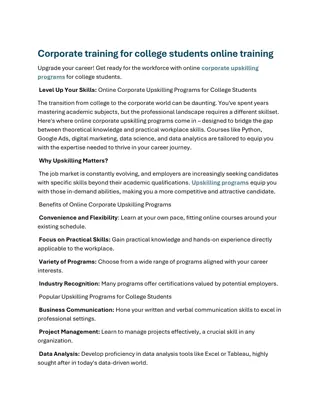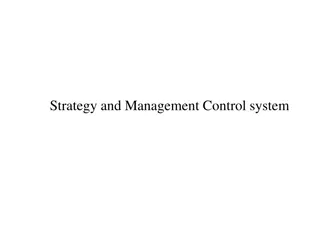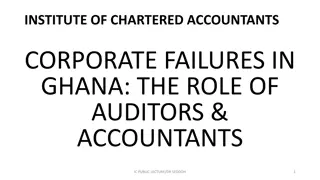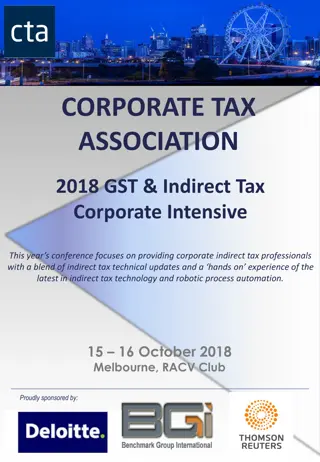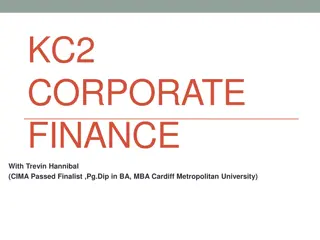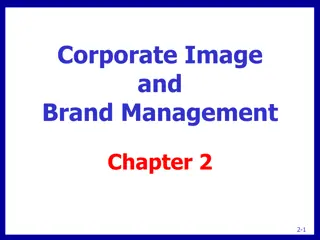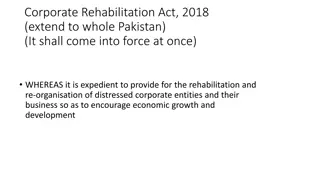Levels of Strategies and Analysis in Corporate Settings
Corporate level strategies play a crucial role in achieving business goals by efficiently allocating resources and making complex decisions. Explore different types of strategies, advantages, and disadvantages in this informative overview.
Download Presentation

Please find below an Image/Link to download the presentation.
The content on the website is provided AS IS for your information and personal use only. It may not be sold, licensed, or shared on other websites without obtaining consent from the author.If you encounter any issues during the download, it is possible that the publisher has removed the file from their server.
You are allowed to download the files provided on this website for personal or commercial use, subject to the condition that they are used lawfully. All files are the property of their respective owners.
The content on the website is provided AS IS for your information and personal use only. It may not be sold, licensed, or shared on other websites without obtaining consent from the author.
E N D
Presentation Transcript
Levels of Strategies and Analysis
Corporate Level Strategies:- Meaning 1. Corporate level strategies help to hit a specific target needed to achieve business goals. 2. It tend to be long term in nature but, allow for dynamic adjustments, based on uncertainty and changing market conditions. 3. It s implemented throughout the entire organizational structure. 4. It involves careful analysis like selection of businesses, the company can compete in.
Features:- Efficient allocation and utilization of scarce resources. Mapped out around the goal and objectives of organisation. Formulated by top management. Complex decision making Revolve around decisions.
Types of corporate level strategies :-
Concentration:- First level type of expansion strategies. They involve trying to compete successfully only within a single industry. It s a strategic approach in which a firm focuses on single product or market. Allows organisation to invest more resources in production & marketing in that particular area. However, carries the risk of losses if decrease in demand level or increase in the level of competition. The product market matrix is as given by H.J. Ansoff in his book the strategies for Diversification has mentioned three types of concentration strategies.
Market Penetration:- It concentrates on gaining additional share of firms existing markets using the existing products. Market development:- It involves sale of same product in the new markets. Market expansion may take place geographically or demographically. Product development strategy:- It involves selling the new product in the same markets. It helps organizations to not only improve its performance but also adds to the firm image, brand strength, product innovativeness & new product quality.
Advantages of concentration strategies:- Enables smooth conduct of business activities Requires minimal organization al changes Enables quick decision making Low initial risks Allows focusing attention Enhances competitive advantage
Disadvantages of concentration strategies:- Heavy dependence on single industry Exposes business to different levels of risks Creates organizational inertia Leads to cash flow problems Profits may be overlooked
Integration:- A common growth strategy. It means combination of business that are separate but complementary to each other. Features Objectives like eliminate competition, control the market, create monopoly, etc. Minimize Risks. Aims at ensuring survival & growth. Considered as well planned conspiracy to create monopoly situation in the market.
Types of Integration:- Lower costs New markets advantages Increased differentiation Reduced competition Horizontal integration Increased market power Destroyed value Legal repercussions Disadvantages Reduced flexibility
Vertical Integration:- Businesses operating at different stages or levels of the same industry is known as vertical integration. Backward Vertical Integration -: It controls subsidiaries that produce some of the inputs used in production of its products. Advantages -: 1. smooth supply of Raw material 2. It enables the company to obtain raw material at lower price but at standard quality 3. Large scale production 4. Power of negotiation with other suppliers 5. Tax savings Disadvantages -: 1. cost of finish goods may exceed the buying cost 2. Integration makes exit from a business at times make more difficult. 3. Technological up gradation is not feasible.
Forward vertical integration:- It controls distribution centre & retailer where its products are sold. Advantages-: 1. Greater control over sales 2. Competitive position & reduce overall cost 3. Increase profits 4. Stable production by own pre-sales or post sales services Disadvantages:- 1. Face financial problems 2. Difficult to cope up with technological changes 3. Success is uncertain
Diversification:- It mean broadening or enlarging the company s product range by introducing new products or by extending the range of existing products. Diversification also means expanding the markets in those geographical areas which up till now were untapped. Examples are Videocon, Wipro, etc.
Reasons for diversification:- Decline of the current business Additional opportunities Consolidation Need related diversification Risk minimization Better utilization of resources Competitive strategy
Challenges for diversification:- No guarantee Huge losses Initiate retaliation moves by the competitors
Types of diversification:- Horizontal diversification:- Concerned with acquisition or development of products or offering new services. Company relies on sales & technological up gradations to add new products to existing product lines. Vertical diversification:- It occurs when the company goes back to previous stages of its production cycle or moves forward to subsequent stages at the same cycle production of raw material or distribution of the final product.
Concentric diversification:- It involves enlarging the production portfolio by adding new products with the aim of fully utilising the existing potential of technologies & marketing system. Its financially efficient as a strategy, since the business may benefit from some synergies in this diversification model. Synergies refer to the 2 + 2 = 5 effect. 1) Marketing synergy 2) Operating synergy 3) Investment synergy 4) Management synergy It enforce some investments related to modernizing or upgrading the existing processes or systems. It often used by small producers.
Heterogeneous ( Conglomerate ) Diversification:- It involves moving to new products or services that have no technological or commercial relation with current products, equipment, distribution channels, but which may appeal to new groups of customers. It gets high return on investments in the new industry. It lead to additional opportunities indirectly related to further development.
Internationalization:- It s a type of expansion strategy followed by those organizations which have to market their products and services beyond the domestic or national market. Organisation need to assess international environment, evaluate its own capabilities & divide strategies to enter the foreign markets.
Types of international strategies:- International strategy Multi domestic strategy Global strategy Transactional strategy
International entry modes:- Export entry modes - firm produces in home country & markets in the overseas. Contractual entry modes Non-equity associations between international company & legal entity in the overseas market. Eg. Licencing, franchising, vice contracts , etc. Investment entry modes Involves ownership of production units in the overseas market based on some form of equity investment or direct foreign investment. Joint ventures, strategic alliances, independent ventures, wholly owned subsidiaries are some of the investment modes of entry. It means the manner in which the firm would commence its international operations.
Advantages of internationalization Disadvantages of internationalization Economies of scale Higher risks Economies of scope Difficulty in managing cultural diversity High bureaucratic costs Expansion & extension of markets Higher Enjoy location economies distribution cost Access to overseas resources Trade barriers
Digitization:- It is the process of changing from analogue to digital form. In this format, information is organized into discrete units of data (bits) that can be separately addressed ( in multiple bytes). Its often used interchangeably used with word digitalization which means the use of digital technologies to change a business model. It s a process of moving to a digital business. Its defined as digital coding of information and transmission that it enables. It has been a progressive phenomenon which resulted into computerization of records for easy & repeated access.
Digitalization strategies:- According to Ravi Kalakota and Marcai Robinson the three phases of digitalization strategies are as below : Choose the e-business patterns. Choose the e-business model. Choose the e-bussines designs.
E-business patterns-: Refers to the chain of relationships between the company & customers or companies and their partners. E-channel patterns Click & brick pattern Brick & motor firms are traditional organizations whereas click & order firms are new types of organizations that make extensive use of information technology. Portal provide different types of services to specific & well defined group of users. E-portal pattern E-market maker or Net market pattern This is an online intermediary that connects disparate buyers & sellers within a common vertical industry. They eliminate inefficiencies of the marketing channel. Pure e-digital products pattern Many products can be produced, delivered, consumed & licensed electronically.
Advantages Disadvantages May create security & integrity issues. Ease in conducting transaction Strengthens documentation & facilitate easy retrieval of information Require advanced technology to be installed. Biometric ID adding to the safety measure Reduces the chances of developing the actual physical contact with the customers. Lowers the start up cost compared to brick/ mortor business. Lack of digital literacy ,Lack of sustainable digital infrastructure are major hurdle. Overcomes the problem of geographical boundries.
Strategic choice:- It is a selection of the best strategic option that helps to achieve organization s objectives. Strategic options are evaluated on the basis of suitability, acceptability & feasibility. Strategic choice is defined as the decision which selects a strategy from among the alternative grand strategies which will best meet the objective of the enterprise. The decision involves focusing on a few alternatives, consideration of the selection factors, evaluating the alternatives against these criteria & making an actual choice.
Process of strategic choice:- Focus on alternatives Evaluation of the strategic alternatives Consideration of decision factors Objective factors Strategic intent SWOT analysis Personal factors Personal preferences & aspirations Value systems Attitude towards risks Internal political considerations Other factors Nature of environment Internal realities of the firm Ambition of owners Company culture Firm s capacity to execute the strategy Resource allocation Making choice of strategy
Factors of strategic choice:- competitors suppliers External environmental factors Dealers & customers Other environmental factors Objective factors Organizational mission Organizational objectives & policies Internal organizational factors Resources Management labour relations
Personal factors of top management Past organizational strategies Value system of top management Subjective factors Attitude towards risk Internal politics Timing considerations
Strategic analysis:- It s an detailed investigation of the objective factors being considered in the process of strategic choice. Here, older techniques are replaced with new ones. It is done at two levels 1. Business level 2. Corporate level
Tools & techniques for strategic analysis:- Corporate portfolio analysis :- It is mainly used by multi-products or multi business firms. GE planning grid, BCG matrix, Hofer s product market evolution are some tools & techniques. Advantages Disadvantages
Corporate parenting analysis:- This technique focuses on the role of corporate headquarters in managing the set of businesses in a corporate portfolio. The way in which each centre manages & nurtures each individual business is termed as corporate parenting. financial control, strategic planning & strategic control are some of the styles adopted for corporate planning.
Advantages Disadvantages Focuses strategic intent & provides clarity. It adds to the costs of the firm. It may be used as a shield or cushion to hide financial reality. Helps to develop the strategic capabilities, & improves the performance of firm. Too much of focus on diversification may lead to lack to clarity. Helps in knowledge creating & sharing by providing expert services & guidance.
Experience curve Analysis :- Its a combination of learning, specialization, economies of scale & investment in technologies. It has got important strategic implications. It is similar to the learning curve. It explains the facts that increase as the learning is gained by the workers through repetitive productive work.
Disadvantages Advantages New technologies may create new experience curve. Enables firm to capture large part of the market than its competitors. Competing firms may be able to replicate the production methods of the leading firms without much effort in gaining experience. It confers cost advantage to the firm
Life cycle analysis:- Introduction Decline stage Growth stage Maturity stage
Advantages Disadvantage Build a portfolio of markets May not produce good results Suggest expansion strategies Useful guide to predict what changes might occur over a period of time Businesses that experience a reverse trend in their life cycle
Industry Analysis:- Its also known as porter s five forces analysis & useful for business strategies. Its based on observation that profit margins vary between industries . The purpose is to determine the attractiveness of an industry. Industry rivalry Threat of substitutes Bargaining power of buyers Bargaining power of suppliers Barriers to entry
Advantages Disadvantages It assumes classic perfect market & a relatively static market which in reality not possible. Help companies to work on strengths &overcome weaknesses Identifies area which require strategic changes Doesn t take into account strategic alliances The assumption that companies try to achieve competitive advantage over other players Competition extends beyond current competitors
Strategic group analysis:- It s aims to identify organizations with similar strategic characteristics, following similar strategies or competing on similar bases. Identify direct competitors Raises the question of possibility for another organisation to move from one strategic group to another. It is used to identify strategic problems & opportunities. Advantages:-
Competitor analysis:- It deals with the actions & reactions of the firms in the same industry or strategic group. It s an assessment of the strengths & weaknesses of current & potential competitors. This analysis provides both an offensive & defensive strategic context to identify opportunities and threats.
Advantages:- Disadvantages:- Enables organisation to devise strategies by understanding the market trends. Enables organisation to grow by planning for expansion & diversification. Provides an insight into future competitor strategies may help in predicting upcoming threats & opportunities. It will be successful only when it is done exhaustively on various dimensions such as their size, growth & profitability, reputation, objectives, culture , etc.
SWOT Analysis:- It s a process where the management team identifies the internal i.e. the strengths & weaknesses that will affect the company s future performance as well as the external factors i.e. opportunities & threats over which the frim doesn t have any control.
Advantages:- Source of information Builds organisations strengths and overcome weaknesses. Maximize its response to opportunities. Helps in identifying core competencies of the firm. Helps in setting of objectives Helps in knowing past, present & future Disadvantages:- Changes in price levels, economic environment , etc. It does stress upon the significance of the four aspects, but doesn t tell how an organisation can identify theses aspects for itself. Categorizing aspects as SWOT might be very subjective due to the uncertainty in market conditions.



